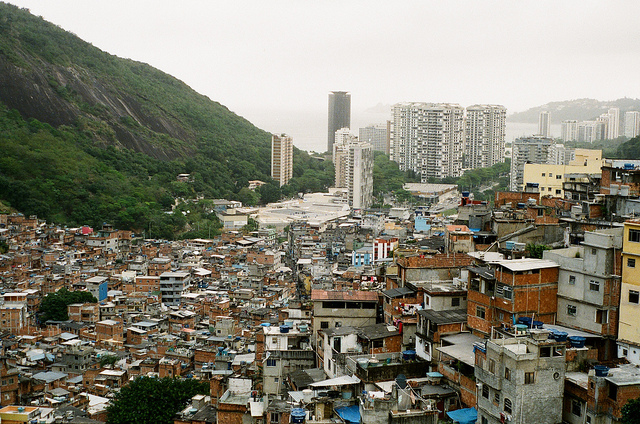
The poverty stricken Rocinha favela bordered by wealthy Zona Sul neighborhoods.
Photo © matteo0702, licensed Creative Commons Attribution.
Rocinha is the poster child of favelas. Because the vast “slum” neighborhood occupies one of the most beautiful, natural settings in Rio – a jungle-crowned mountain overlooking the sea – it is one of the city’s most photographed favelas. And because it borders two of the city’s most flagrantly wealthy Zona Sul neighborhoods, São Conrado and Gávea, Rocinha is the also the favela that most shockingly and poignantly symbolizes the vast divide between rich and poor that comprises one of Brazil’s most defining and challenging realities.
The issues surrounding Rio’s favelas, the drug trade, police, militias, and government officials (both corrupt and enlightened) are incredibly complex and multi-layered – not to mention fascinating.Much has been written about the Rio de Janeiro state government’s determination to crack down on drug-related crime and violence that have long plagued favelas and spilled into other parts of the city. Upon winning hosting duties of the 2014 World Cup and the 2016 Olympic Games, the government got serious about driving out drug lords, and the accompanying violence they engendered, and installing UPPs (Police Pacification Units) charged with maintaining security.
To date, police and military forces have implanted 19 UPPs (the vast majority in regions within proximity of middle and upper class neighborhoods of the Zona Sul). However, last Sunday’s operation into Rocinha was the biggest yet, involving 3,000 armed security personnel (not to mention hordes of Brazilian and foreign journalists in bullet-proof vests – choice portions were streamed live on TV by Brazil’s leading Globo network).
Unlike previous operations, some of which claimed casualties, the invasion of Rocinha and the neighboring favela of Vidigal (perched above the chic beach bairro of Leblon) went off without a single gunshot being fired. Of course, due to the favela’s location – and the fact that alongside 90,000 poor and working class residents, the favela is home to countless NGOs and is often visited by young Cariocas enamored of the neighborhood’s funk parties as well as curious foreign tourists – countless preparations had been made beforehand.
Indeed, the fact that the invasion was announced days in advance allowed most traffickers to steal away beforehand. Strangely enough (or not), the only one who didn’t get away was Antônio Bonfim Lopes (alias “Nem” ), Rocinha’s biggest and baddest drug king, who ruled over the favela for the last six years. A colorful character straight out of a B-movie, Nem has undergone plastic surgery to disguise himself and, only last year, he faked his death (funeral and all) to throw police off his scent. Despite his many efforts – including monthly police bribes that supposedly averaged US$700,000 (chump change for a guy whose average monthly earnings are estimated at around US$ 5 million) – Nem was nabbed by police just before the launch of the somewhat oxymoronically named “Operação Choque de Paz” (Operation Shock of Peace).
It remains to be seen whether peace in Rocinha, and in other “occupied” favelas, will be temporary – or permanent. In terms of Rocinha, the implantation of the UPP is only the first step in improving life in this city within a city. Experts warn that change is only possibly with the implantation of social programs aimed at improving residents’ quality of life through access to education and jobs as well as to basic public services. As it is, only 5 percent of Rocinha’s population receives any government welfare. Only 21 percent of residents possess indoor plumbing, a mere 12 percent have their garbage collected regularly, and just 33 percent have mail delivered to their door.
The issues surrounding Rio’s favelas, the drug trade, police, militias, and government officials (both corrupt and enlightened) are incredibly complex and multi-layered – not to mention fascinating. I recommend that anyone interested in obtaining a more profound and objective grasp of the situation read a blog called Rio Radar. Created by American citizen and Carioca transplant, Andrew Fishman, the blog offers a clear look at public security issues in Rio by offering a mixture of Brazilian media (translated) and original content (videos and interviews) with Brazilians behind the scenes including favela dwellers, member of special police forces, and government officials. For a great overview of it all, read Fishman’s recently published op-ed page in which he offers his own personal (but highly informed) take on favela pacification to date.